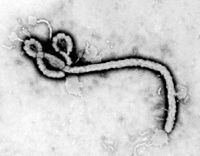Group Group V ((−)ssRNA) Scientific name Filoviridae | Rank Family | |
 | ||
Filoviridae pathology of ebola virus wmv
The family and CDC Filoviridae (members are called Filovirus) is the taxonomic home of several related viruses that form filamentous infectious viral particles (virions), and encode their genome in the form of single-stranded negative-sense RNA. Two members of the family that are commonly known are Ebola virus and Marburg virus. Both viruses, and some of their lesser known relatives, cause severe disease in humans and nonhuman primates in the form of viral hemorrhagic fevers. All ebolaviruses and marburgviruses are Select Agents, World Health Organization Risk Group 4 Pathogens (requiring Biosafety Level 4-equivalent containment), National Institutes of Health/National Institute of Allergy and Infectious Diseases Category A Priority Pathogens, Centers for Disease Control and Prevention Category A Bioterrorism Agents, and listed as Biological Agents for Export Control by the Australia Group. It is expected that cuevaviruses will be classified in a similar way in the near future.
Contents
- Filoviridae pathology of ebola virus wmv
- Microbiology step1 filoviridae
- Use of term
- Note
- Family inclusion criteria
- Family organization
- Nomenclature below species level
- Phylogenetics
- Life cycle
- Paleovirology
- Vaccines and concerns
- References
Microbiology step1 filoviridae
Use of term
The family Filoviridae is a virological taxon that was defined in 1982 and emended in 1991, 1998, 2000, 2005, 2010 and 2011. The family currently includes the three virus genera Cuevavirus, Ebolavirus, and Marburgvirus and is included in the order Mononegavirales. The members of the family (i.e. the actual physical entities) are called filoviruses or filovirids. The name Filoviridae is derived from the Latin noun filum (alluding to the filamentous morphology of filovirions) and the taxonomic suffix -viridae (which denotes a virus family).
Note
Filoviridae is pronounced ˌfiːloʊ’viːrɨdɛ (IPA) or fee-loh-vee-ri-deh in English phonetic notation. According to the rules for taxon naming established by the International Committee on Taxonomy of Viruses (ICTV), the name Filoviridae is always to be capitalized, italicized, never abbreviated, and to be preceded by the word "family". The names of its members (filoviruses/filovirids) are to be written in lower case, are not italicized, and used without articles.
Family inclusion criteria
A virus that fulfills the criteria for being a member of the order Mononegavirales is a member of the family Filoviridae if:
Family organization
Table legend: "*" denotes type species.
Nomenclature below species level
Recommendations have been made for the identification of these viruses below the species level. These include the use of virus name / strain / isolation host-suffix / country of sampling / year of sampling / genetic variant designation / isolate designation. The use of the suffix "rec" is recommended if the virus has been identified via recombinant DNA.
Phylogenetics
The mutation rates in these genomes have been estimated to be between 0.46 × 10−4 and 8.21 × 10−4 nucleotide substitutions/site/year. The most recent common ancestor of both the Reston and Zaire species has been estimated to be ~1960. The most recent common ancestor of the Marburg and Sudan species appears to have evolved 700 and 850 years before present respectively. Although mutational clocks placed the divergence time of extant filoviruses at ~10,000 years before the present, dating of orthologous endogenous elements (paleoviruses) in the genomes of hamsters and voles indicated that the extant genera of filovirids had a common ancestor at least as old as the Miocene (~16-23 million or so years ago).
Life cycle
The filovirus life cycle begins with virion attachment to specific cell-surface receptors, followed by fusion of the virion envelope with cellular membranes and the concomitant release of the virus nucleocapsid into the cytosol. The viral RNA-dependent RNA polymerase (RdRp, or RNA replicase) partially uncoats the nucleocapsid and transcribes the genes into positive-stranded mRNAs, which are then translated into structural and nonstructural proteins. Filovirus RdRps bind to a single promoter located at the 3' end of the genome. Transcription either terminates after a gene or continues to the next gene downstream. This means that genes close to the 3' end of the genome are transcribed in the greatest abundance, whereas those toward the 5' end are least likely to be transcribed. The gene order is therefore a simple but effective form of transcriptional regulation. The most abundant protein produced is the nucleoprotein, whose concentration in the cell determines when the RdRp switches from gene transcription to genome replication. Replication results in full-length, positive-stranded antigenomes that are in turn transcribed into negative-stranded virus progeny genome copies. Newly synthesized structural proteins and genomes self-assemble and accumulate near the inside of the cell membrane. Virions bud off from the cell, gaining their envelopes from the cellular membrane they bud from. The mature progeny particles then infect other cells to repeat the cycle.
Paleovirology
Filoviruses have a history that dates back several tens of million of years. Endogenous viral elements (EVEs) that appear to be derived from filovirus-like viruses have been identified in the genomes of bats, rodents, shrews, tenrecs, tarsiers, and marsupials. Although most filovirus-like EVEs appear to be pseudogenes, evolutionary analyses suggest that orthologs isolated from several species of the bat genus Myotis have been maintained by selection.
Vaccines and concerns
There are presently no licensed vaccines for known filovirus. There has been a pressing concern that a very slight genetic mutation to a filovirus such as EBOV could result in a change in transmission system from direct body fluid transmission to airborne transmission, as was seen in Reston virus (another member of genus Ebolavirus) between infected macaques. A similar change in the current circulating strains of EBOV could greatly increase the infection and disease rates caused by EBOV. However, there is no record of any Ebola strain ever having made this transition in humans.
